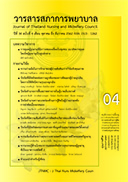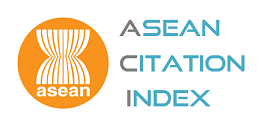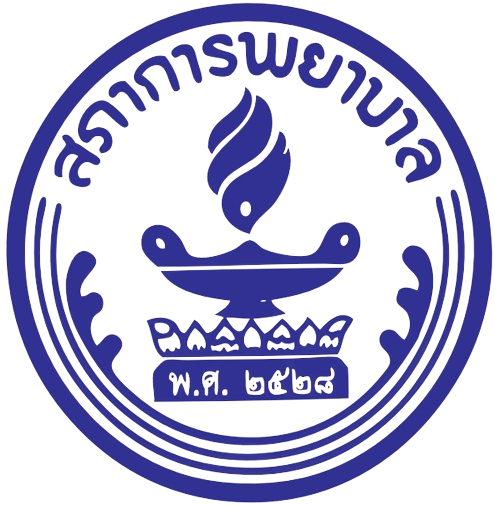ปัจจัยที่มีอิทธิพลต่อความถูกต้องในการคัดแยกผู้ป่วยฉุกเฉิน โดยการใช้ดัชนีความรุนแรงฉุกเฉิน
คำสำคัญ:
ความถูกต้องของการคัดแยก, ผู้ป่วยฉุกเฉิน, พยาบาลคัดแยก, การฝึกอบรมตามหลักสูตร, อายุผู้ป่วย, โรคร่วม, ประสบการณ์ทำงานบทคัดย่อ
วัตถุประสงค์การวิจัย:เพื่อศึกษาอิทธิพลของประสบการณ์ทำงานที่แผนกฉุกเฉิน การฝึกอบรมของพยาบาล อายุผู้ป่วย และโรคประจำตัวผู้ป่วย ต่อความถูกต้องของการคัดแยกผู้ป่วยฉุกเฉินโดยการใช้ดัชนีความรุนแรงฉุกเฉิน
การออกแบบการวิจัย: การวิจัยความสัมพันธ์เชิงทำนาย
การดำเนินการวิจัย: กลุ่มตัวอย่างเป็นพยาบาลคัดแยก 78 คน และผู้ป่วยผู้ใหญ่ 780 คน ที่มารับบริการที่แผนกฉุกเฉิน โรงพยาบาลระดับตติยภูมิ เขตกรุงเทพมหานครและปริมณฑล สังกัด กระทรวงสาธารณสุข จำนวน 7 แห่ง เก็บรวมข้อมูลโดยใช้แบบสอบถามข้อมูลส่วนบุคคลของพยาบาลคัดแยก แบบสอบถามข้อมูลส่วนบุคคลของผู้ป่วย แบบประเมินภาวะโรคร่วมของชาร์ลสันและคณะแบบรวบรวมผลลัพธ์ดัชนีความถูกต้อง และแนวทางการคัดแยกดัชนีความรุนแรงฉุกเฉิน ฉบับที่ 4 วิเคราะห์ข้อมูลด้วยสถิติพรรณนา และการวิเคราะห์ถดถอยโลจิสติกพหุกลุ่ม
ผลการวิจัย:กลุ่มตัวอย่างพยาบาลคัดแยก ทำการคัดแยกผู้ป่วยได้ถูกต้อง ร้อยละ 68.7 สำหรับ การคัดแยกที่สูงกว่าระดับจริง พบว่า พยาบาลที่มีประสบการณ์ทำงานที่แผนกฉุกเฉิน 6 - 10 ปี และมากกว่า 10 ปี มีโอกาสเกิดน้อยกว่าพยาบาลที่มีประสบการณ์ 1 - 5 ปี (OR 0.14, 95% CI 0.09 - 0.23;OR 0.31, 95% CI: 0.19 - 0.52, p < 0.01) ส่วนการคัดแยกที่ต่ำกว่าระดับจริง พบพยาบาลที่มีประสบการณ์ทำงานที่แผนกฉุกเฉิน 6 - 10 ปี จะมีโอกาสเกิดน้อยกว่าพยาบาลที่มีประสบการณ์ 1 - 5 ปี (OR 0.33, 95% CI 0.17 - 0.64, p < 0.01) นอกจากนั้นพยาบาลที่ผ่านการอบรมคัดแยกผู้ป่วย มีโอกาสคัดแยกต่ำกว่าระดับจริงมากกว่าพยาบาลที่ไม่ได้ผ่านการอบรม (OR 3.54, 95% CI: 1.99 - 6.27. p < 0.01) ผู้ป่วยที่มีอายุมากกว่า 65 ปี มีโอกาสถูกคัดแยกต่ำกว่าระดับจริง 2.43 เท่า เมื่อเปรียบเทียบกับผู้ป่วย
อายุ 18 - 54 ปี (OR 2.43, 95% CI: 1.27 - 4.65, p < 0.05) และโรคประจำตัวไม่มีอิทธิพลต่อความถูกต้องของการคัดแยกผู้ป่วยฉุกเฉิน โดยการใช้ดัชนีความรุนแรงฉุกเฉิน
ข้อเสนอแนะ:คุณสมบัติของพยาบาลคัดแยก ควรมีประสบการณ์ทำงานที่แผนกฉุกเฉิน อย่างน้อย 5 ปี และได้รับการอบรมคัดแยกผู้ป่วยตามหลักสูตรมาตรฐาน เพื่อลดโอกาสเกิดการคัดแยกผิดพลาด สำหรับ ผู้ป่วยที่มีอายุมากกว่า 65 ปี ต้องได้รับการจัดระดับความเร่งด่วนตามแนวปฏิบัติ และเฝ้าระวังอย่างต่อเนื่อง
Downloads
References
operational information for commissioning (Central); 2017.
2. Sirisamitr T, Wachiradilok P. Annual report 2016 National Institute for Emergency Medicine. Bangkok:
Ultimate Printing; 2017. (in Thai)
3. UCEP coordination center, National Institute for Emergency Medicine. Universal coverage for emergency
patients: UCEP 2018 [cite 2018 March 7]. Available from: https://www.niems.go.th/th/Upload/File/256104091000232914_EtLeXFtU5mKNUd49. pdf. (In Thai)
4. Somma DS, Paladino L, Vaughan L, Lalle I, Magrini L, Magnanti M. Overcrowding in emergency department:
an international issue. Intern Emerg Med. 2015;10(2):171-5.
5. Wachiradilok P, Sirisamutr T, Chaiyasit S, Sethasathien A. A nationwide survey of Thailand emergency departments
triage systems. TJNC 2559;31(2):96-108. (In Thai)
6. Gilboy N, Tanabe P, Travers D, Rosenau AM. Emergency Severity Index (ESI): a triage tool for emergency
department care, version 4. implementation handbook, 2012 edition: Rockville, MD: Agency for Healthcare
Research and Quality; 2011.
7. Richardson DB. Increase in patient mortality at 10 days associated with emergency department overcrowding.
Med J Australia. 2006;184(5):213-6.
8. Sittichanbuncha Y. Triage. In: Yuksen C and Sittichanbuncha Y, editors. ER RAMA. Bangkok: Vista interprint; 2011.
(in Thai)
9. Fathoni M, Sangchan H, Songwathana P. Relationships between triage knowledge, training, working experiences
and triage skills among emergency nurses in East Java, Indonesia. Nurse Media Journal of Nursing 2013;
3(1):511-25.
10. Soontorn T, Sitthimongkol Y, Thosingha O, Viwatwongkasem C. Factors influencing the accuracy of triage by registered nurses in trauma patients. Pacifc Rim Int J Nurs Res 2018; 22(2):120-30.
11. Nakahara S, Matsuoka T, Ueno M, Mizushima Y,Ichikawa M, Yokota J, et al. Predictive factors for
undertriage among severe blunt trauma patients: what enables them to slip through an established trauma
triage protocol? J Trauma 2010;68(5):1044-51.
12. Platts‐Mills TF, Travers D, Biese K, McCall B, Kizer S,LaMantia M, et al. Accuracy of the Emergency Severity
Index triage instrument for identifying elder emergency department patients receiving an immediate life-saving
intervention. Acad Emerg Med 2010;17(3):238-43.47
13. Cox S, Morrison C, Cameron P, Smith K. Advancing age and trauma: triage destination compliance and
mortality in Victoria, Australia. Injury 2014;45(9): 1312-29.
14. Hinson J, Martinez D, Schmitz P, Toerper M, Radu D, Scheulen J, et al. Accuracy of emergency department triage
using the Emergency Severity Index and independent predictors of under-triage and over-triage in Brazil:
a retrospective cohort analysis. Int J Emerg Med 2018;11(1):1-10.
15. Barnett K, Mercer SW, Norbury M, Watt G, Wyke S, Guthrie B. Epidemiology of multimorbidity and
implications for health care, research, and medical education: a cross-sectional study. Lancet 2012;
380(9836):37-43.
16. Xiang H, Wheeler KK, Groner JI, Shi J, Haley KJ. Undertriage of major trauma patients in the US emergency
departments. Am J Emerg Med 2014;32(9):997-1004.
17. Benjamin ER, Khor D, Cho J, Biswas S, Inaba K, Demetriades D. The age of undertriage: current
trauma triage criteria underestimate the role of age and comorbidities in early mortality. J Emerg Med.
2018;55(2):278-87.
18. Ahmad R, Cherry RA, Lendel I, Mauger DT, Service SL, Texter LJ, et al. Increased hospital morbidity
among trauma patients with diabetes mellitus compared with age- and injury severity score-matched control
subjects. Archives of Surgery 2007;142(7):613-8.
19. Donabedian A. The quality of care. How can it be assessed? JAMA 1988;260(12):1743-8.
20. Chen SS, Chen JC, Ng CJ, Chen PL, Lee PH, Chang WY. Factors that influence the accuracy of triage
nurses’ judgement in emergency departments. Emer Med J 2010;27(6):451-5.
21. Charlson ME, Charlson RE, Peterson JC, Marinopoulos SS, Briggs WM, Hollenberg JP. The Charlson Comorbidity
Index is adapted to predict costs of chronic disease in primary care patients. J Clin Epidemiol 2008;61(12):
1234-40.
22. Durand AC, Gentile S, Gerbeaux P, Alazia M, Kiegel P, Luigi S, et al. Be careful with triage in emergency
departments: interobserver agreement on 1,578 patients in France. BMC Emerg Med 2011;11(1):1-10.
23. Pimdee E, Prompinit S, Mitsungnuen T, Pugoen P. Inter-rater reliability of triage patients among outpatient
department, accident and emegency department nurses and emergency physicians in Srinagarind Hospital.
Srinagarind Med J 2015;30(6):587-91. (in Thai)
24. Bergs J, Verelst S, Gillet JB, Vandijck D. Evaluating implementation of the Emergency Severity Index in a Belgian Hospital. J Emerg Nurs 2014;40(6):592-7.
25. Garbez R, Carrieri-Kohlman V, Stotts N, Chan G, Neighbor M. Factors influencing patient assignment
to level 2 and level 3 within the 5-level ESI triage system. J Emerg Nurs 2011;37(6):526-32.
26. Vibulwong P, Rittiwong T. A competency evaluation of participants from the emergency nurse training
program at Boromarajonani Collage of Nursing, Bangkok. Journal of Boromarajonani Collage of
Nursing, Bangkok 2014;30(1):72-85. (in Thai)
27. Navaratnarajah A, Jackson SH. The physiology of ageing. Medicine 2013;41(1):5-8.
28. Justiniano CF, Evans DC, Cook CH, Eiferman DS, Gerlach AT, Beery Ii PR, et al. Comorbiditypolypharmacy score: a novel adjunct in post–emergency department trauma triage. J Surg Res 2013;181(1): 16-9.







